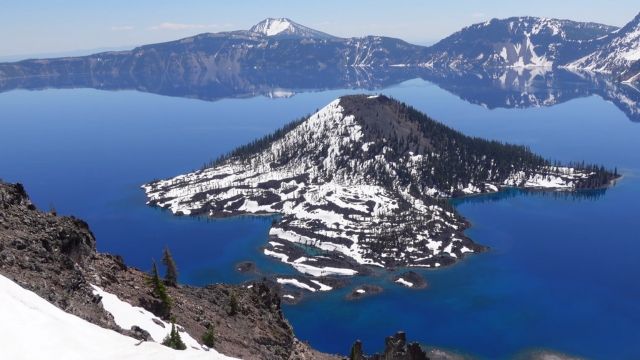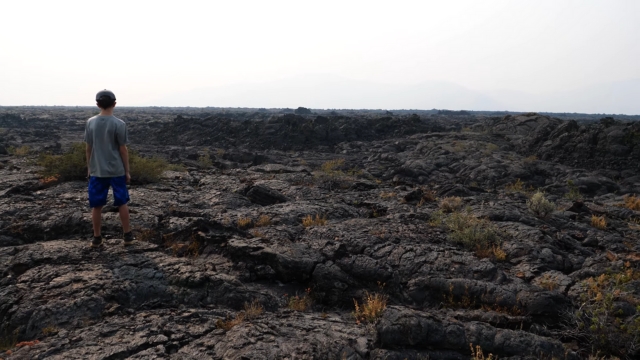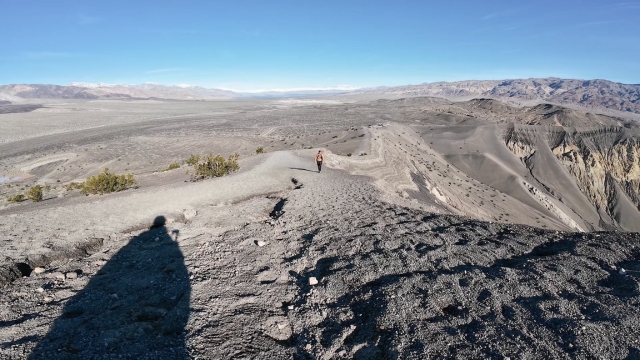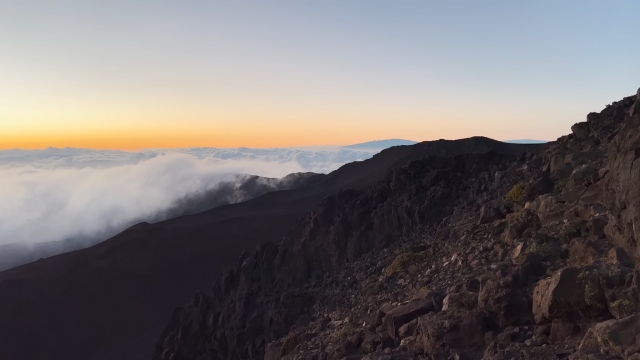Have you ever caught yourself daydreaming about walking across a place so wild and strange that it feels like stepping into another planet? Volcanoes and craters hold that kind of power.
They remind us that the Earth is alive, shifting and breathing in ways both dangerous and breathtaking. Parks built around them offer something rare: a chance to not just look at geological history, but to physically walk across it.
Hiking through these landscapes in 2025 can feel almost meditative. The crunch of lava rock underfoot, the sudden hiss of steam vents, or the stillness around a vast crater – each moment pulls you into the story of Earth’s restless spirit.
Let’s look closely at some of the most remarkable volcanic and crater parks worth your time this year, paired with practical tips so you can experience them fully and safely.
Hawai’i Volcanoes National Park
Few places on Earth capture the raw, ongoing drama of volcanic activity like Hawai’i Volcanoes National Park. Spread across 323,431 acres, the park is home to Mauna Loa, the largest volcano on Earth, and Kilauea, one of the world’s most active.
Over 100 miles of trails carry hikers through rainforests, lava deserts, and steaming vents. In 2024 alone, more than 1.6 million people visited – a testament to its draw.
For 2025, it remains one of the most unmissable parks for anyone interested in volcanoes.
Key Trails Worth Exploring
- Crater Rim Trail: A loop around Kilauea’s summit caldera, this trail showcases vast views and volcanic steam rising from cracks in the ground. Its asphalt sections make it more accessible than other rugged paths, but sun and exposure require preparation.
- Kilauea Iki Trail: Perhaps the most famous hike here. The 3.2-mile loop drops 400 feet from lush rainforest to the floor of a lava lake that solidified after the spectacular 1959 eruption. Crossing the warm crater floor, knowing fountains once shot 1,900 feet into the sky, is unforgettable. Allow 3-4 hours, and be ready for moderate difficulty.
- Maunaulu Trail: This path winds across lava flows from 1969 to 1974 before climbing Pu’uhuluhulu Cinder Cone for sweeping views. It’s a moderate few miles, ideal for reflecting on how life slowly pushes back into once-barren ground.
- Pu’uloa Petroglyphs: Shorter but culturally rich, this trail crosses lava fields etched with thousands of ancient Hawaiian carvings. It connects geology to human history in a powerful way.
Safety and Practical Notes
Conditions can change quickly. Volcanic gases, unstable terrain, and extreme sun exposure are real risks. Closed-toe shoes, liters of water, and sun protection are musts.
Some trails, like Napau Crater, remain closed in 2025 due to new lava flows – always check the park’s official updates before setting out.
Crater Lake National Park

Where Mount Mazama once towered, a collapsed caldera now holds the deepest lake in the United States – Crater Lake. At 1,943 feet, its depth and clarity make it feel bottomless, and the surrounding rim offers endless viewpoints.
The explosion that created it 7,700 years ago left behind a scene that feels both serene and awe-inspiring.
Trails That Showcase the Lake’s Magic
- Cleetwood Cove Trail: The only way to reach the water itself. This 2.2-mile round trip drops 700 feet to the shoreline. You can swim in the frigid, crystal-clear lake or catch a boat tour. The return climb is a challenge, but that effort lingers in your memory.
- Mount Scott Trail: A 4.4-mile round trip to the highest point in the park at 8,929 feet. Views stretch in all directions, with Wizard Island – a cinder cone rising from the lake – standing out.
- Garfield Peak Trail: At 3.4 miles and nearly 1,100 feet of gain, this moderate-to-strenuous trail rewards hikers with sweeping caldera panoramas, meadows of wildflowers, and butterfly sightings.
- Watchman Peak Trail: A shorter, 1.6-mile path with a steady climb that leads to one of the best sunset viewpoints around the rim.
Things to Keep in Mind
In 2025, road repairs mean certain rim access points may be closed until September, so plan ahead. Snow can linger well into summer, making conditions unpredictable.
Dogs are not allowed on trails. With half a million annual visitors, early starts help with both parking and solitude.
Haleakalā National Park
View this post on Instagram
High above Maui, Haleakalā offers a hiking experience unlike anywhere else. Its crater is seven miles wide and 2,600 feet deep, a massive depression filled with cinder cones and rare silversword plants. The shifting light and silence create an almost spiritual atmosphere.
Trails Inside the Crater
- Sliding Sands (Keonehe’ehe’e) Trail: The park’s signature hike. Descend 2,500 feet over four miles to the crater floor, with options to extend into loops up to 11 miles. The colorful cinder cones, sometimes referred to as Pele’s Paint Pot, glow red, orange, and purple in the shifting sun.
- Halemau’u Trail: A challenging 11-mile shuttle hike connecting switchbacks to Sliding Sands, offering panoramic views and surreal stretches across lava. Silversword plants, found only here, line parts of the path.
- Shorter Loops: For those not ready for the long haul, half-mile loops near the visitor centers still reveal unique volcanic terrain.
Planning Ahead
Permits for sunrise access are required and bookable 60 days in advance. Temperatures swing between 30°F and 65°F, even in summer, so layers are essential.
There are no shuttles; hitchhiking is common among hikers doing one-way routes. Staying on marked trails protects the fragile ecosystem.
Craters of the Moon National Monument

Few parks live up to their name as literally as Craters of the Moon. With 750,000 acres of cinder cones, lava tubes, and vast basalt flows, the landscape truly looks extraterrestrial.
The most recent eruptions occurred as recently as 2,000 years ago, geologically speaking, just yesterday.
Key Trails
- Lava Flow Trail: Easy and accessible, it winds through jagged remnants of cooled lava, offering a perfect first taste of the park’s surreal terrain.
- Tree Molds and North Crater Trails: Walk past lava-encased tree shapes or explore a crater rim and floor combination. Distances vary, making it easy to customize a visit.
Tips for Visitors
There are no restaurants here, so pack your own supplies. The monument is also a certified International Dark Sky Park, meaning nighttime stargazing is phenomenal in 2025.
Around 200,000 people visit annually, making it far less crowded than many better-known destinations.
Sunset Crater Volcano National Monument
@arizonatravelideas 📍 Sunset Crater Volcano National Monument located NE of Flagstaff, AZ Cost: $25 a vehicle or use your America The Beautiful Pass They do offer the junior ranger program here! Things to do: hiking, visitor’s center, scenic views, scenic drive Have you been? What did you think? #Arizona #ArizonaTravel #ArizonaTravelIdeas #Flagstaff #FlagstaffAZ #NationalParks #northernarizona ♬ original sound – Arizona Travel Ideas
Just north of Flagstaff, Sunset Crater showcases the aftermath of a volcanic eruption from 1085 AD. The cinder cone, still blackened and striking, is surrounded by ponderosa forests and lava bombs scattered across the ground.
Hikes to Try
- Lava Flow Trail: A short, easy-to-moderate loop through lava rock and cinder fields. Ranger-led tours often bring added cultural and geological insight.
- Cinder Hills Recreation Area: Not just for hikers – off-road enthusiasts use the rolling cinder dunes for unique adventures.
The 34-mile scenic loop connecting Sunset Crater with Wupatki National Monument ties geological history with ancestral Puebloan ruins, offering a layered cultural experience.
Ubehebe Crater

Ubehebe Crater in California’s Death Valley is the result of a violent steam explosion that blasted open the earth 600 feet deep.
Hiking around or into the crater gives a direct look at just how destructive – and beautiful – such an event can be.
- Rim Trail: A 1.5-mile loop with shifting gravel underfoot, rated moderate.
- Descent to the Floor: Steep and challenging, but walking into the crater adds scale to the experience.
- Little Hebe: A smaller crater nearby that makes for an easy add-on.
Wind is often fierce, and summer heat can soar past 110°F.
Active Volcano Hikes Around the World Beyond the U.S.
For those seeking international adventures, 2025 offers several standout volcano hikes:
- Mount Etna, Italy: Europe’s highest active volcano at 11,165 feet. Guided tours are required above 9,500 feet.
- Stromboli, Italy: Known for frequent eruptions every 10-20 minutes. Night hikes with guides reveal glowing lava fountains.
- Villarrica, Chile: A strenuous climb with crampons, but the option to slide down on snow makes it unforgettable.
- Pacaya, Guatemala: A shorter, family-friendly hike where visitors can roast marshmallows on hot rocks.
- Mount Meakan, Japan: Located in Akan-Mashu National Park, with steaming craters and rugged alpine terrain.
- Masaya, Nicaragua: Trails to viewpoints like Mirador Cruz de Bobadilla give rare glimpses into a lava lake, though access in 2025 is limited due to landslide impacts.
View this post on Instagram
Comparative Trail Snapshot
| Park/Trail | Distance (miles) | Difficulty | Elevation Gain (feet) | Unique Feature |
| Kilauea Iki | 3.2 | Moderate | 400 | Solidified lava lake floor |
| Cleetwood Cove | 2.2 | Moderate | 700 | Swim in deepest U.S. lake |
| Sliding Sands | 4-11 | Strenuous | 2,500 | Vibrant cinder cones |
| Ubehebe Rim | 1.5 | Moderate | Variable | Explosion crater |
| Etna Summit | Up to 11 | Challenging | To 11,165 | Active lava fields |
Final Thoughts
Hiking volcanoes and craters is a chance to step directly into Earth’s ongoing story. Each trail is a reminder of resilience, both natural and human.
You see how landscapes destroyed by fire eventually grow forests again, how water fills a void left by collapse, and how cultures adapt to living in the shadow of eruptions.
The narrow sandstone passages of the Zebra Slot Canyon hike show another side of geologic power, where time and erosion create patterns as striking as fire and ash.
For 2025, whether your choice is Hawai’i, Oregon, Idaho, or far beyond, the experience will leave you with more than photos. It leaves you with perspective, with questions, and with a renewed sense of connection to the forces that shape our world.
Pack wisely, check conditions, and go with respect for the places you walk through. After all, they’ve been shaping history long before our footprints touched them.

